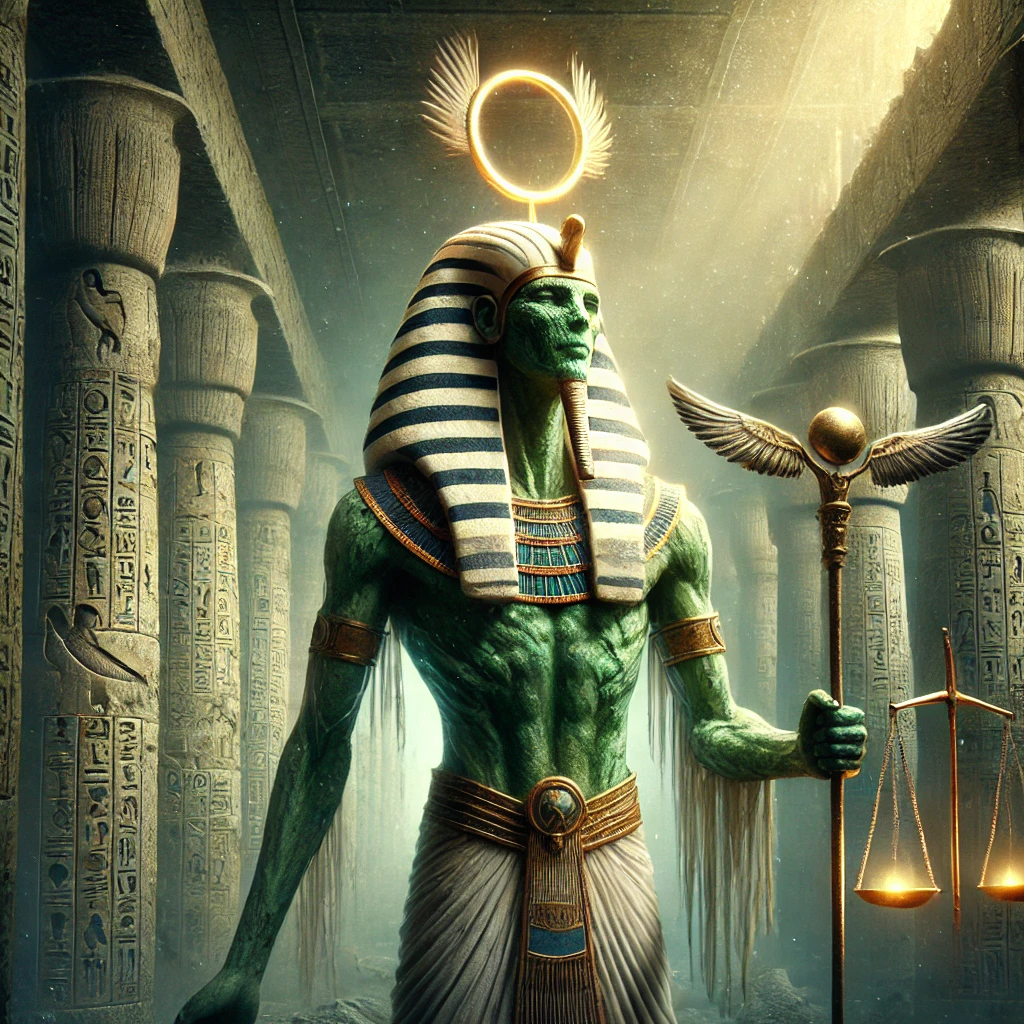Definition
Osiris is the ancient Egyptian god of the underworld, resurrection, and eternal life. He is also associated with fertility, vegetation, the cycles of nature, and divine kingship. As the ruler of Duat (the Egyptian afterlife), Osiris presides over the judgment of souls and the rebirth of the spirit. Revered as both a benevolent judge and a symbol of immortality, Osiris plays a central role in Egyptian religion and mythology as the eternal king and redeemer of the dead.
Origins and Mythological Role
Osiris (Egyptian name: Asar or Wesir) was one of the most ancient deities in the Egyptian pantheon, with worship dating back to at least the Fifth Dynasty (c. 2494–2345 BCE).
Family and Lineage
- Son of: Geb (Earth) and Nut (Sky)
- Brother of: Isis, Nephthys, and Seth
- Husband of: Isis
- Father of: Horus
Osiris was originally a fertility and agricultural deity, associated with the annual flooding of the Nile and the rebirth of crops. Over time, his role expanded to encompass the cycle of life, death, and resurrection, becoming the ruler of the afterlife and patron of the dead.
The Osirian Myth
One of the most important stories in Egyptian mythology centers on the death and resurrection of Osiris:
- Betrayal and Murder: Osiris was a wise and just king who brought civilization to Egypt. His brother, Seth, driven by jealousy and ambition, murdered Osiris and scattered his body parts across the land.
- Restoration and Resurrection: Osiris’s wife and sister, Isis, with the help of Nephthys, Thoth, and Anubis, gathered and magically reassembled his body. Through divine magic, Isis revived Osiris long enough to conceive their son, Horus.
- Ruler of the Underworld: After his resurrection, Osiris did not return to the living world. Instead, he became Lord of the Duat, where he ruled as the eternal king and judge of the dead, offering hope for immortality and rebirth.
Symbols and Iconography
- Atef Crown – A tall white crown with feathers on each side, symbolizing divine authority and the afterlife.
- Crook and Flail – Emblems of kingship and divine rule, often crossed over his chest.
- Green or Black Skin – Green represents fertility and rebirth; black symbolizes the rich soil of the Nile and resurrection.
- Mummified Form – Osiris is often depicted as a wrapped mummy, indicating his association with death and the afterlife.
- Djed Pillar – Symbol of stability and Osiris’s spine, representing the strength of eternal life.
He is typically shown:
- As a mummified man with exposed hands holding the crook and flail
- Wearing the Atef crown and ceremonial beard
- Standing or seated on a throne in the Hall of Ma’at during judgment scenes
Roles and Powers
1. Ruler of the Afterlife (Duat)
Osiris governs the realm of the dead, where souls journey after death. He judges the deceased in the Weighing of the Heart ceremony, ensuring that only the righteous gain eternal life.
2. God of Resurrection and Immortality
His resurrection myth makes him a symbol of eternal renewal, representing the possibility of life after death. This belief was central to Egyptian funerary rites.
3. Symbol of Divine Kingship and Order
Osiris established Ma’at (cosmic order) and served as a model of divine rulership. Each pharaoh was seen as a living Horus and, upon death, became one with Osiris.
4. Patron of Agriculture and Fertility
Osiris is closely linked to the cycles of nature, especially the flooding of the Nile, which brought fertility to the land. His death and rebirth mirrored the growth and dormancy of crops.
Temples and Worship
Abydos – The Sacred City of Osiris
- Abydos was the most important cult center for Osiris.
- The Temple of Seti I contains a famous Osireion, a symbolic tomb of Osiris.
- Pilgrims journeyed to Abydos to participate in Passion Plays reenacting Osiris’s death and resurrection.
Widespread Veneration
- Osiris was honored in temples, household shrines, and funerary rituals across Egypt.
- Osiris Festivals, such as the Feast of Khoiak, celebrated the god’s myth with dramatic processions, rites of mourning, and joyous renewal.
The Weighing of the Heart Ceremony
In the Hall of Two Truths, the soul of the deceased is judged before Osiris:
- Anubis weighs the person’s heart against the feather of Ma’at.
- Thoth records the result.
- If the heart is lighter or equal in weight, the soul is welcomed by Osiris into the Field of Reeds (eternal paradise).
- If the heart is heavier, it is devoured by Ammit, and the soul ceases to exist.
Spiritual Significance and Modern Interpretation
Today, Osiris is recognized as:
- A symbol of spiritual transformation, rebirth, and inner resurrection
- A guide for those undergoing grief, loss, or deep personal change
- An embodiment of divine justice and compassion in the afterlife
- A representation of the divine masculine in harmony with life, death, and rebirth
Osiris is often invoked in spiritual practices related to ancestral honoring, protection of the dead, dreamwork, and shadow healing.
Conclusion
Osiris stands as one of the most profound figures in Egyptian mythology—a god who dies, is reborn, and becomes ruler of the underworld, guiding the souls of the dead with justice and mercy. He symbolizes the promise of life beyond death, the strength of spiritual continuity, and the enduring power of love and devotion. As the eternal king, he remains a beacon of transcendence, wisdom, and divine renewal across time.

